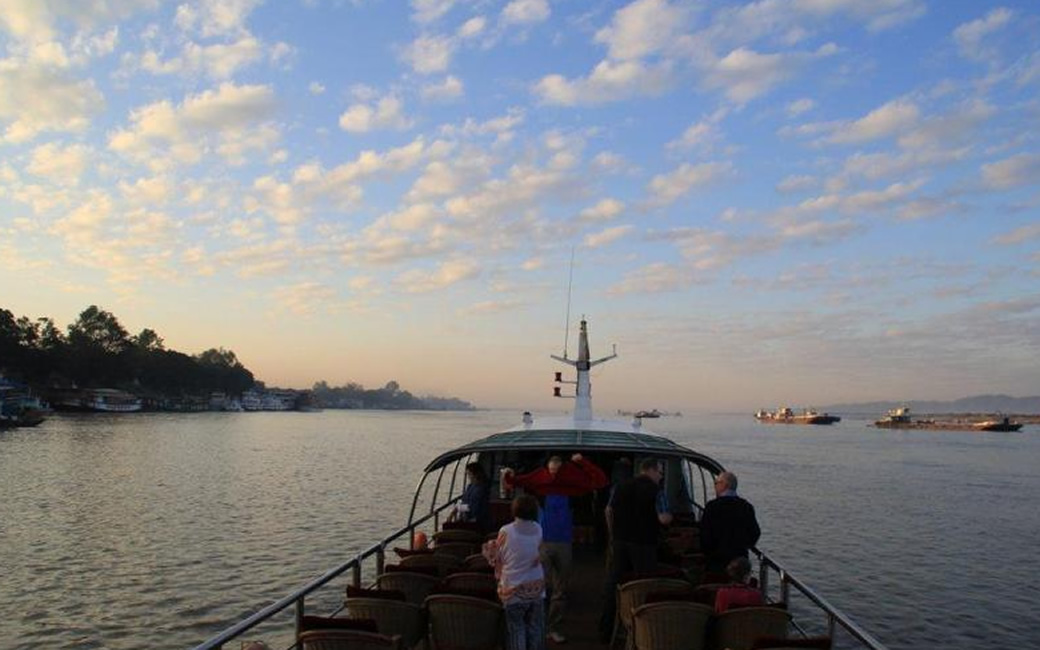The taxi took us along dark roads, gradually dimming to dawn, to the 6.30 ferry to Bagan, docked and boarding passengers. We took a seat buzzing with the last tired and innocuous mosquitoes of the night.
The first few miles from Mandalay are lined by hills covered with more pagodas than I thought possible, but soon after it’s just flat banks offering an occasional peek into the lives of the sparse river dwellers. With the exception of two simple meals nothing happens for 10 hours. Nothing. A confined space with no mobile coverage or the bliss of modern technology. When was the last time it happened? As scary as it sounds it was liberating and I feel joyful every time I think back to that day.
A spectacular sunset in Nyaung-U
We reached Bagan at dusk. The boat turned off the engines as we silently glided in the bay. Black trees and stupas sharply silhouetted against the orange-to-navy-blue hue of the sky, and large bats hovered above us, dancing around the bright full moon.
This almost surreal poetry was quickly broken by reality as we moored: the boat was swarmed by people grabbing bags to secure passengers for their taxis and in a couple of hectic minutes we were all off board.
We let this commotion steam off until we’re approached by a man offering a taxi rate that would be probably realistic in New York. We teamed up with a Canadian couple to negotiate, levering on the fact we were almost the last passengers left.
The rough edges of tourism in Bagan
The taxi facilitator had been aggressive and hostile, a stark contrast with the kindness we’ve encountered in Mandalay, surely an inappropriate behaviour in the contest. At least we got to destination – which at some point of the drive was no longer obvious – to the guest-house where the reception had unsurprisingly no trace of our booking. Without much effort we got them to accommodate us anyway so we dropped the bags in our room and headed out for dinner. It seemed we arrived at the right time, as dinner was being served in the open area at the entrance of the guest-house. “Can we eat here?” I asked a short man, probably the manager.
“No.”
A man of few words, but maybe he misunderstood. With a broad smile, I tried to make myself clear with various food-related synonyms supplemented with the eloquent Italian gesture language.
“No.”
That man then proceeded to become my sworn enemy during our stay. Deaf to any request – unless it was for giving him money for a couple of appalling tours – unable to understand or speak English, but mastering it pretty well when he found out we bought the bus tickets to get out of Bagan with another agency.
Is this how tourism will turn all of Myanmar into? A cynical money machine? Why does it always have to be like this? The inevitable human greed pushes the individual, albeit a small percentage of the whole population, to exploit the visitors, while on the other end the naive tourist facilitates the process allowing this behaviour.
This costs like a mars bar
Tea houses: a peaceful haven for hardened stomachs
But faith in the Burmese people is hard to lose. We reached a tea house, few door down from the Golden Hotel, which would then become my daily provider of meals. The décor was down to the bare essential, concrete floors and plastic chairs, no English was spoken but the guys there were really nice. After being almost scared by our presence they gradually started smiling at us and making us feel welcome, as if we were guests at somebody’s house. There was a sort of local-pub feel, with families gathered there to talk, chill and watch the football match on TV. Premier league was on (apparently is a big thing in Myanmar) and I even pretended to support one of the two teams playing in order to win the favours of the locals. We ordered the only two dishes we managed to understand: Cantonese rice and the best Shan noodles I’ve ever tried. Green tea and peace of mind were on the house.

Leave a Reply